
Class Asteroidea
Order Valvatida
Family Asteropseidae
LEATHER STAR
Dermasterias imbricata (Grube, 1857)
Identification:
5 (rarely 6) broad arms with a smooth, slippery surface. Aboral surface mottled reddish brown with greenish-grey margins. Oral side pale and smooth. Smells garlic-like. To 30 cm (12 in) across.
Range:
Alaska to southern California; intertidal to 91 m (299 ft).
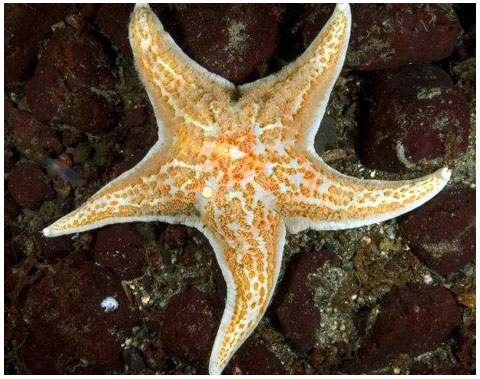
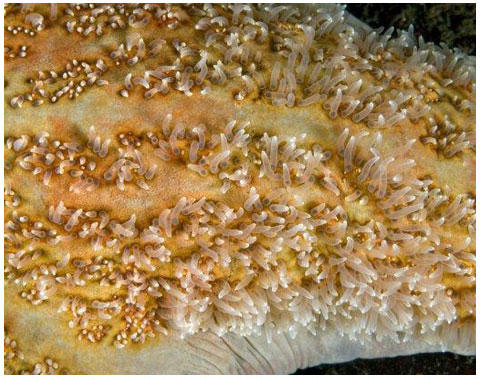
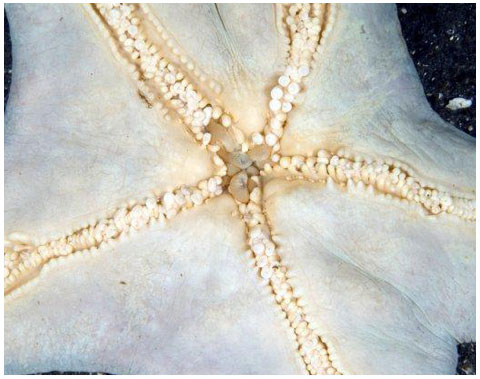
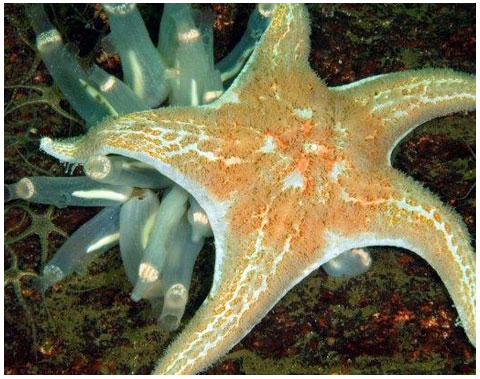
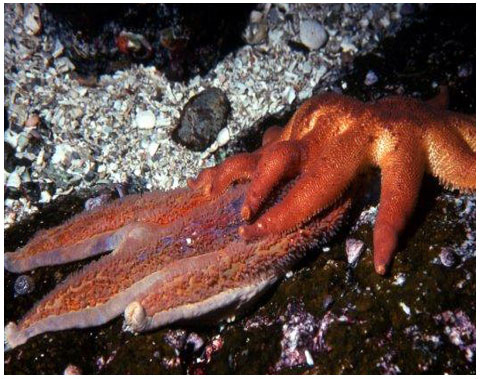





A typical LEATHER STAR. Note the mottled brown/red colour and patches of clustered gills
A close-up view of the aboral surface showing the numerous, rather long gills. The gills can be totally withdrawn into the body wall.
The smooth, pale oral surface. The folds of the cardiac stomach can be seen inside the central mouth.
A LEATHER STAR eats a cluster of SEA VASE TUNICATES in Sechelt Inlet, BC.
This LEATHER STAR has been attacked and is being eaten by a MORNING SUN STAR in Jervis Inlet, BC.
When touched by a LEATHER STAR, a SWIMMING SEA ANEMONE expands, swivels on its base and releases its hold on the bottom, flapping away from the predator.
A LEATHER STAR eats a cluster of colourful STRAWBERRY ANEMONES.
A small ROSE ANEMONE releases its hold on the bottom and "rolls" away from an attack by a LEATHER STAR.
A large ROSE ANEMONE everts its stomach and fights back when attacked by a LEATHER STAR, usually causing the predator to retreat.
A COMMENSAL WORM lies in a groove on the aboral side of a LEATHER STAR. The worm hitches a ride on the sea star and shares its meals.
6 - 10
Previous
NEXT
Notes:
Eats a wide variety of prey, depending on the locale. On the open coast it consumes plumose anemones and tunicates; in sheltered areas it eats orange sea pens, sea vase tunicates, encrusting sponges and bryozoans.
In field studies I carried out in Jervis Inlet, a southern fjord on the BC coast, the LEATHER STAR was the prey for 50% of 80 feeding MORNING SUN STARS. The LEATHER STAR is quite a slow-poke (maximum speed of 15 cm/min) and is easily overtaken by the faster MORNING SUN STAR. In this case the "preference" shown by the MORNING SUN STAR appeared to be a function of the relative abundance of LEATHER STARS in the study area. It was one of the most numerous shallow-water stars at the study sites and therefore a randomly hunting morning sun star would be more likely to encounter it. Lab experiments indicated that the MORNING SUN STAR is unable to detect prey at a distance and relies on chance encounters to find a meal.
The LEATHER STAR is rather famous as one of the stars that elicits the amazing response of the SWIMMING SEA ANEMONES (Stomphia didemon and Stomphia coccinea). These orange anemones react with a bizarre escape response when contacted by the LEATHER STAR, whose skin contains imbricatine, an alkaloid chemical thought to be the cause. When touched, the anemone first expands, spreading the oral disc wide. Then it swings the upper part of the column in a circle while detaching its basal disc from the substrate. Once detached it flaps back and forth for a short time before settling to the bottom and eventually reattaching. Over 40 years of diving I've never seen a LEATHER STAR actually capture a SWIMMING SEA ANEMONE so the escape response is certainly effective. Is there in fact a predator/prey relationship? Probably so, as the LEATHER STAR is known to eat PLUMOSE ANEMONES (Metridium senile and Metridium farcimen), and the STRAWBERRY ANEMONE Corynactis californica.
The LEATHER STAR also elicits a fascinating response from the ROSE ANEMONE Urticina piscivora. When touched, a juvenile anemone expands its oral disc and releases its hold on the substrate but does not swim. Larger anemones have been observed to "fight back" by distending the mouth to envelope the attacking star. In the end the LEATHER STAR usually retreats and both the star and the anemone are none the worse for wear.
Many LEATHER STARS are hosts to the RED-BANDED COMMENSAL WORM Arctonoe vittata. This pale, unruffled scale worm is often quite large relative to its host and reportedly will not tolerate another worm on its home turf, nipping interlopers with its strong jaws.
INTRODUCTION | ABOUT SEA STARS | BIOLOGY | SPECIES | PREDATORS / PREY | SEA STAR WASTING DISEASE | ACKNOWLEDGEMENTS | FIELD GUIDE | VIDEO
Copyright © 2018 All rights reserved.